Sai Harshini from the class of 2022 gets placed at AB InBev
 Yadlapalli Sai Harshini, a student from the Department of Computer Science & Engineering has received a mesmerizing job offer from the world’s largest brewing company, AB InBev, in the Engineering Campus Placement for the class of 2022. She will soon start working at the Global Capability Centre located in Bangalore with a CTC of 12LPA.
Yadlapalli Sai Harshini, a student from the Department of Computer Science & Engineering has received a mesmerizing job offer from the world’s largest brewing company, AB InBev, in the Engineering Campus Placement for the class of 2022. She will soon start working at the Global Capability Centre located in Bangalore with a CTC of 12LPA.
The first shortlisting round was an online test with multiple-choice questions on aptitude, domain knowledge, and coding; followed by a group discussion. The third round was a technical interview based on the resume, followed by an HR interview.
In the words of Sai Harshini:
I am so happy to receive the offer from the world’s largest beverage and brewing company, AB InBev. The inclusion of Industry Standard Coding Skills & Industry Standard Employability Skills courses in the curriculum right from the first semester has helped me hone my coding and communication skills continuously. The projects I’ve done and my research publications with Dr Manikandan have made me stand out from the crowd. The extra-curricular activities at the university I’m part of, Student Council and Social Media Ambassadors, helped me understand perspectives, gain morale, exposure to working in a team and social skills.
The resources provided, sessions before the recruitment drive and the talks with our seniors organised by the CR & CS department helped me get an idea of how the process is going to be and what I need to be prepared for. Thanks to the CR&CS department, the CCC team, and all my mentors. My advice to my peers and juniors is to not worry about what you don’t have, instead be confident and ready to justify what you have. That’s what I’ve done.
The Department of Corporate Relations & Career Services (CR&CS) at SRM University-AP interacts closely with the industry to make the university a favoured destination for national and international organisations looking to recruit fresh talent. The CR&CS Department, SRM University-AP, considers the placement process very crucial and extends every kind of support to ensure that the students are given the best opportunities to streamline their career interests.
- Published in CR&CS, CR&CS NEWS, CSE NEWS, News, Students Achievements
Vivek Vardhan from ECE files design copyright
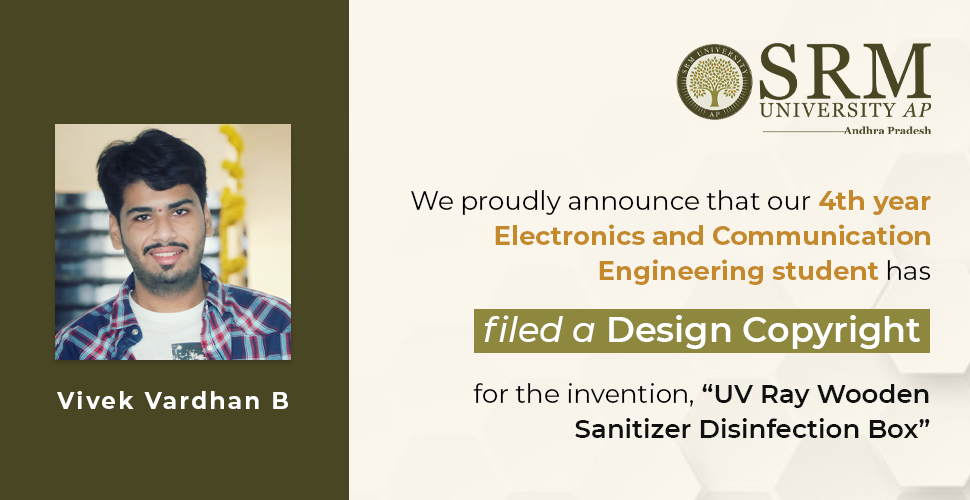 Bitragunta Vivek Vardhan, a final year student from the Department of Electronics and Communication Engineering, has filed a design copyright for developing a “UV Ray Wooden Sanitizer Disinfection Box”. This is a safe chemical-free product designed to disinfect the surfaces of items. In this period of the Covid-19 pandemic, it has been difficult to sanitize mobile phones, tabs, laptops, car/bike keys, wallets, currency/coins, credit/debit cards, newspapers, pens, goggles, spectacles, accessories, milk packets, bakery items, water-absorbing products, delivery packages, toys, clothes etc with liquid sanitisers or else with water.
Bitragunta Vivek Vardhan, a final year student from the Department of Electronics and Communication Engineering, has filed a design copyright for developing a “UV Ray Wooden Sanitizer Disinfection Box”. This is a safe chemical-free product designed to disinfect the surfaces of items. In this period of the Covid-19 pandemic, it has been difficult to sanitize mobile phones, tabs, laptops, car/bike keys, wallets, currency/coins, credit/debit cards, newspapers, pens, goggles, spectacles, accessories, milk packets, bakery items, water-absorbing products, delivery packages, toys, clothes etc with liquid sanitisers or else with water.
Researchers say that the coronavirus stays on surfaces of plastic (3-7 days), stainless steel (3-7 days), copper (up to 4 hours), paper (up to 4 days), glass (4 days), cardboard (24 hours), and wood (up to 2 days). UVC has a wavelength of 10 nm to 400 nm and is used for the disinfection method that has short-wavelength light to kill or inactivate microorganisms by destroying nucleic acids and disrupting their DNA, leaving them unable to perform vital cellular functions. The UVC light used in the product will not penetrate into solid surfaces and it is safe to use on touchscreen mobiles, laptops, tabs, etc. It is also proven that the disinfection box can destroy the bacteria and viruses on the surface of food items without causing any harm to the edibility.
“In future, I have plans to take this project to the next level by designing large dimensions of the box and making it work automatically with remote control through our mobile phone. I am extremely happy about filing the copyright and I express my heartfelt gratitude to Prof Siva Sankar Sir and Pro VC Prof D Narayana Rao Sir for giving me the opportunity and supporting me to expand my idea up to the level of implementation. And I thank Prof Vinod Kumar Sir for taking care of the filing process. Finally, I thank SRM University-AP for encouraging and nurturing young talents in all ways possible, “ Vivek stated.
- Published in Departmental News, ECE NEWS, News, Research News, Students Achievements
Advances of surface-enhanced Raman and IR spectroscopies
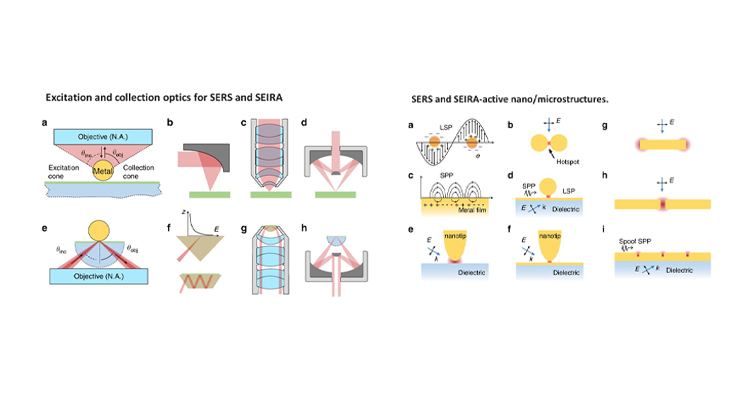 Dr Rajapandiyan Paneerselvam from the Department of Chemistry has published a paper titled “Advances of surface-enhanced Raman and IR spectroscopies: from nano/microstructures to macro-optical design” in the journal Light: Science & Applications, Volume 10, Article number: 161 (2021) having an Impact factor of 17.7.
Dr Rajapandiyan Paneerselvam from the Department of Chemistry has published a paper titled “Advances of surface-enhanced Raman and IR spectroscopies: from nano/microstructures to macro-optical design” in the journal Light: Science & Applications, Volume 10, Article number: 161 (2021) having an Impact factor of 17.7.
Raman and infrared (IR) spectroscopy are powerful analytical techniques, which are widely used for a variety of applications including food analysis, environmental analysis, chemical, and biomolecule analysis. This review article presents some latest advancements in vibrational spectroscopic techniques, and further developments in this field are given with emphasis on emerging techniques and methodologies.
This article has been published with Prof Zhong-Qun Tian’s group, State Key Laboratory of Physical Chemistry of Solid Surfaces, Collaborative Innovation Center of Chemistry for Energy Materials, College of Chemistry and Chemical Engineering, Xiamen University, Xiamen, 361005, China.
Furthermore, Dr Rajapandiyan’s research group will focus on the development of plasmonic nanostructures for surface-enhanced Raman spectroscopy and its applications in food science, spectroelectrochemistry, and microfluidics in the future.
Read the full paper here: https://doi.org/10.1038/s41377-021-00599-2
- Published in Chemistry-news, Departmental News, News, Research News
Heterojunction photocatalyst for the degradation and mineralization of pharmaceutical effluent: Clozapine
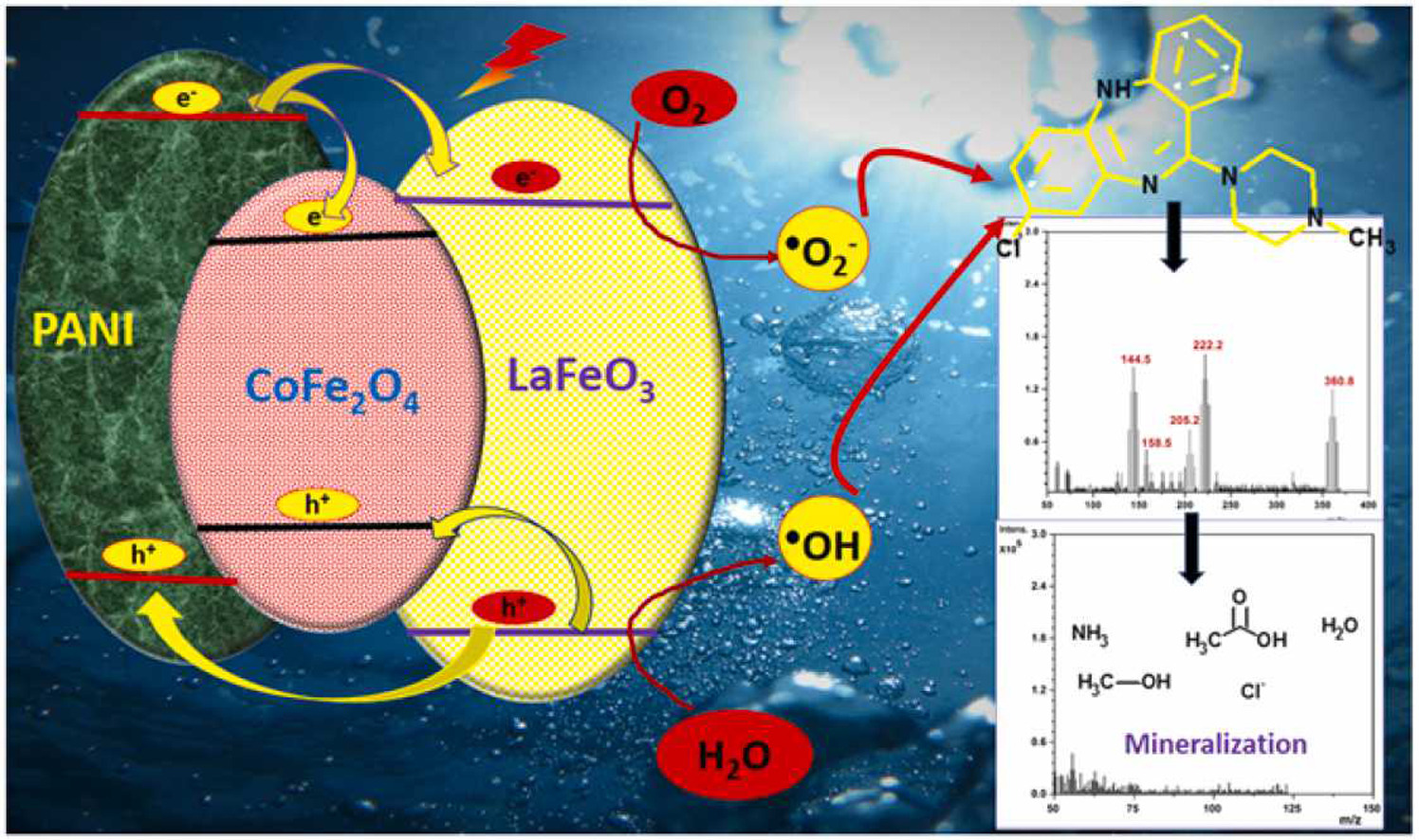 A research paper titled “Robust visible light active PANI/LaFeO3/CoFe2O4 ternary heterojunction for the photo-degradation and mineralization of pharmaceutical effluent: Clozapine” has been published by Dr Lakhveer Singh from the Department of Environmental Science at SRM University – AP, as a co-author, in Journal of Environmental Chemical Engineering, having an Impact Factor of 5.90.
A research paper titled “Robust visible light active PANI/LaFeO3/CoFe2O4 ternary heterojunction for the photo-degradation and mineralization of pharmaceutical effluent: Clozapine” has been published by Dr Lakhveer Singh from the Department of Environmental Science at SRM University – AP, as a co-author, in Journal of Environmental Chemical Engineering, having an Impact Factor of 5.90.
Clozapine (CZP) is a second-generation antipsychotic medicine prescribed for the treatment of resistant schizophrenia. The reported side effects of CZP includes cardiometabolic, orthostatic hypotension, tachycardia, seizures, myocarditis, weight gain and obesity. In this research, a novel magnetic ternary PANI/LaFeO3/CoFe2O4 (PLC) heterojunction photocatalyst was developed for the degradation and mineralization of pharmaceutical effluent: Clozapine. The photocatalysts were found to be re-usable for 5 consecutive cycles.
This work has been in collaboration with Central University Jammu. The present study has a new insight into the development and fabrication of efficient ternary heterojunction towards promising application prospects in wastewater remediation.
Dr Lakhveer Singh is an Editorial Board member of the Journal of Biomass Conversion and Biorefinery – Springer (I.F. 2.60) and a Guest Editor for Bioresource Technology Reports- Elsevier.
Read the full paper here: https://doi.org/10.1016/j.jece.2021.106159
- Published in Departmental News, ENVS News, News, Research News
K Jeevan Sai from CSE lands in NielsenIQ with 11.79 LPA
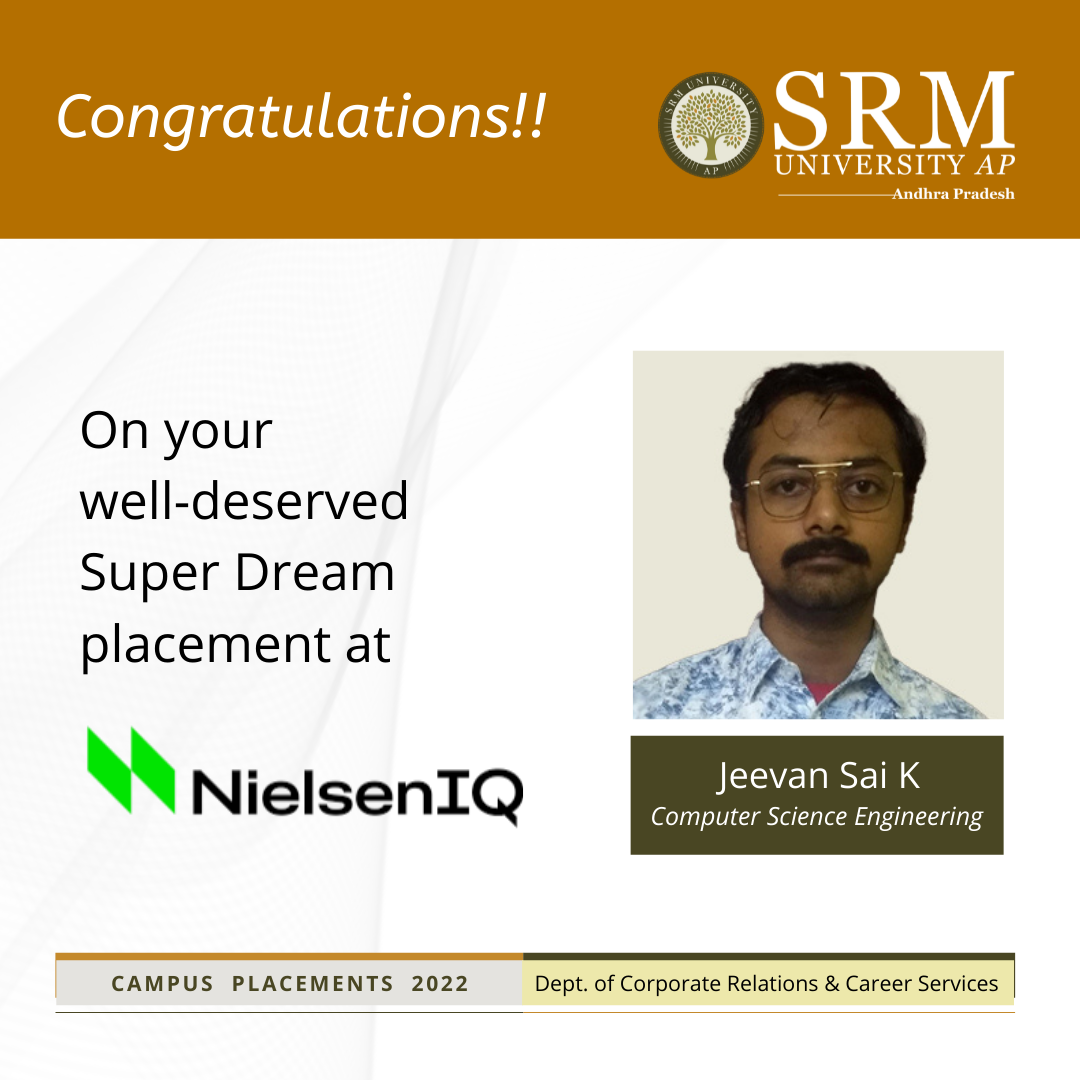 Kanaparthi Jeevan Sai, a B Tech final year student from the Department of Computer Science & Engineering, has secured an exciting job offer with an annual salary package of 11.79 lakhs from NielsenIQ, an industry leader in data points, detailed intelligence, and solutions. He will join the organisation as a full-time Java Software Engineer and work from the Chennai location.
Kanaparthi Jeevan Sai, a B Tech final year student from the Department of Computer Science & Engineering, has secured an exciting job offer with an annual salary package of 11.79 lakhs from NielsenIQ, an industry leader in data points, detailed intelligence, and solutions. He will join the organisation as a full-time Java Software Engineer and work from the Chennai location.
NielsenIQ Consumer LLC is a dream destination for students who specialize in core areas of engineering. For the first three years, the university provided the students with the basics of programming, technical languages, data structures and algorithms. And later in the final year, the placement cell designed student-specific intensive training for all students aspiring for high-paying jobs. The training also covered all the possible model questions for coding rounds and discussed the pattern of previous years.
Jeevan Sai says that the projects need to be presented according to the company and it is important that the resume is well-written and simple. “Group discussions and some of the sessions which helped us to improve our personal and interview abilities and public speaking were arranged by the Department of CR&CS in association with Barclays (also a company). These and were led by industry experts. I thank the placement department for being very active throughout the placement season and clearing our doubts effectively, “Jeevan Sai stated.
- Published in CR&CS, CR&CS NEWS, CSE NEWS, Departmental News, News, Students Achievements
Dr Balaga Mohana Rao receives Best PhD Thesis award from IIT Bombay
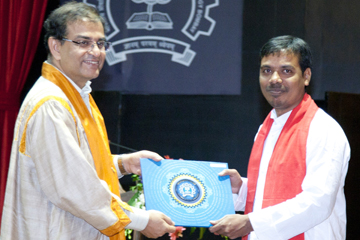 Dr Balaga Mohana Rao, Assistant Professor from the Department of Economics has been awarded the best PhD thesis award in the 59th IIT Bombay convocation held on August 07, 2021. The thesis titled The Early Warnings of the Impending Currency Crises and the Ensuing Macroeconomic Costs aims to develop an Early Warning System to identify the Currency Crises that would help in preventing an impending crisis and also in mitigating the devastating aftermath effects if that occurred.
Dr Balaga Mohana Rao, Assistant Professor from the Department of Economics has been awarded the best PhD thesis award in the 59th IIT Bombay convocation held on August 07, 2021. The thesis titled The Early Warnings of the Impending Currency Crises and the Ensuing Macroeconomic Costs aims to develop an Early Warning System to identify the Currency Crises that would help in preventing an impending crisis and also in mitigating the devastating aftermath effects if that occurred.
The financial crises have enthused a huge theoretical and empirical debate in current times due to their recurrent nature in the history of economics. To highlight the importance of an economic crisis among various sections, Kaminsky et al. (1998) quote Kindleberger (1978) saying that academics are interested in a crisis as they have had a history of fascination for the crises, policymakers are interested because they want to prevent the crisis, and financial market participants are interested as they can make money out of it. The financial crises can be divided into two broad categories—currency and sudden stop crises, and debt and banking crises. The currency crises have not only swept away Argentina (2001), Brazil (1998–1999), Latin America (the 1980s), Russia (1998), Southeast Asia (1997) and UK (1992) (to name a few) but they also have caused serious economic adversities to India and BRICS in the recent past. A currency crisis encompasses one of the following four features or a combination of them owing to a speculative attack—both successful and unsuccessful attacks—on a currency: A sharp depreciation of a currency (possibly followed by devaluation) and/or huge depletion of foreign exchange reserves or an increase in interest rates by the central bank or imposing restrictions on capital flows. In this context, Dr Balaga Mohana Rao’s thesis focuses on developing an early warning system to identify the impending crises, finding the common determinants of currency crises and the aftermath effects on macroeconomic indicators.
“One may wonder why the crisis should be prevented or mitigated. The reason is that a full-blown crisis will not be just confined to the foreign exchange market or some other segment, but it will affect the whole economy” Dr Balaga said. He plans to extend his PhD work on Currency Crises and see it in the context of the International Price System.
- Published in Departmental News, Economics Current Happenings, Economics News, News, Research News
Final year students get placed in ZS Associates
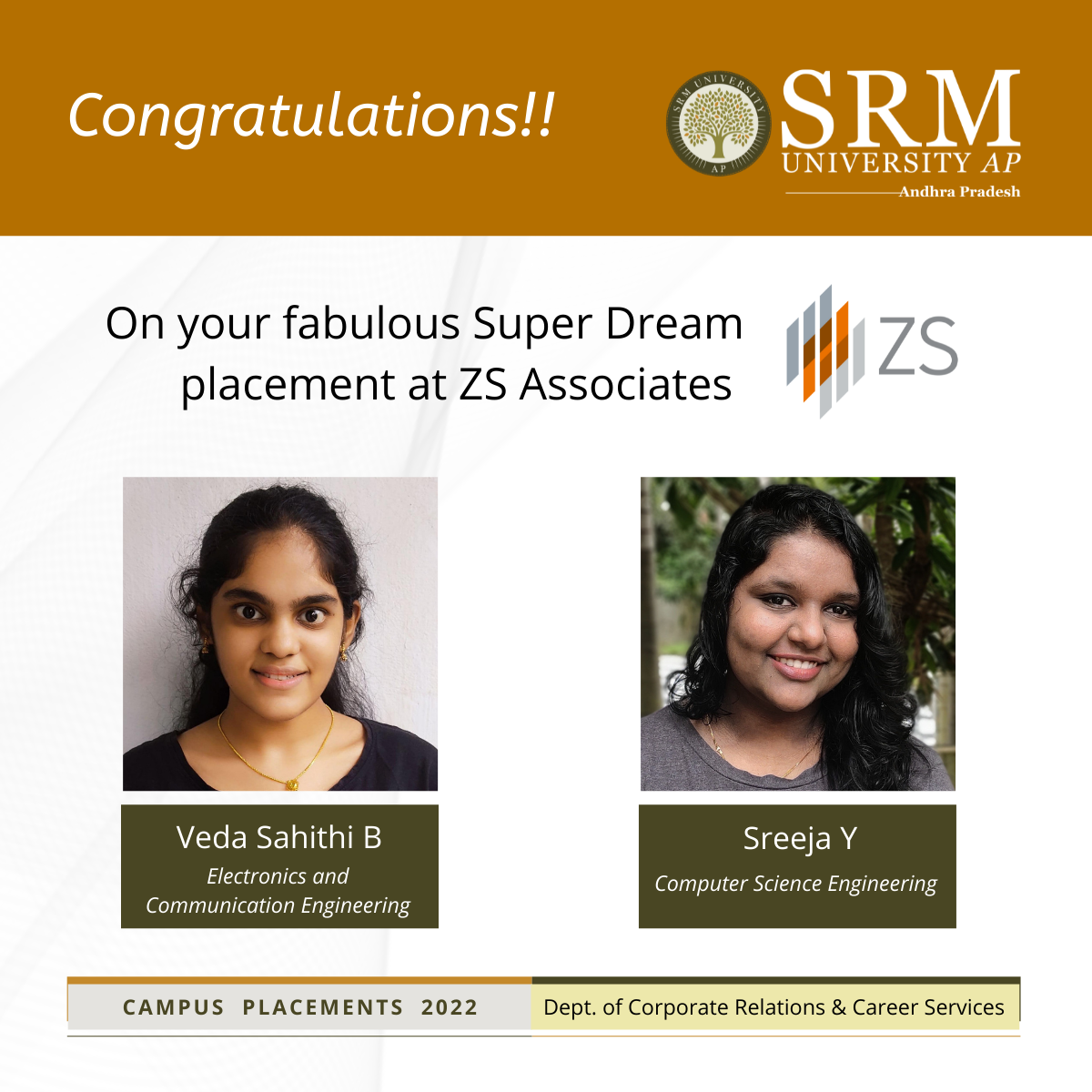 Bandi Veda Sahithi from the Department of Electronics and Communication Engineering, and Sreeja Y from the Department of Computer Science Engineering have been placed at ZS Associates with an exciting CTC of 14.35 LPA.
Bandi Veda Sahithi from the Department of Electronics and Communication Engineering, and Sreeja Y from the Department of Computer Science Engineering have been placed at ZS Associates with an exciting CTC of 14.35 LPA.
Students started their preparation two months prior to the month of placements (approximately April-May and placements started in July). Following a disciplined timetable, and the CCC training given by the university, students have achieved their dream job offers! As Sreeja Y is a Computer Science Engineering Student, she mainly focused on DSA, DBMS, OOPs, OS and Aptitude (sources she used to prepare are Geekofgeeks, YouTube, Hackerrank, Leetcode for coding, W3schools).
The Curriculum for placement provides intensive training for 1 and a half month where the students receive CCC training, Domain training (TIME), and Aptitude training. The CCC Classes helped students understand DSA concepts and apply those concepts in coding. In the Domain training students were taught DSA, CN, OOPs, OS and it helped them further in SQL, DBMS concepts.
Sreeja expresses her gratitude for the guidance, training and sources of knowledge she received from SRM University-AP. “Approximately 75 companies lined up for recruitment in a month. Placement Cell really gives us great and wide opportunities to achieve our goals.” “The placement cell is a wonderful interactive platform that connects various companies with the university, providing abundant opportunities”, added Veda Sahithi.
- Published in CSE NEWS, Departmental News, ECE NEWS, News, Students Achievements
CSE students to transform the future through Accolite Digital
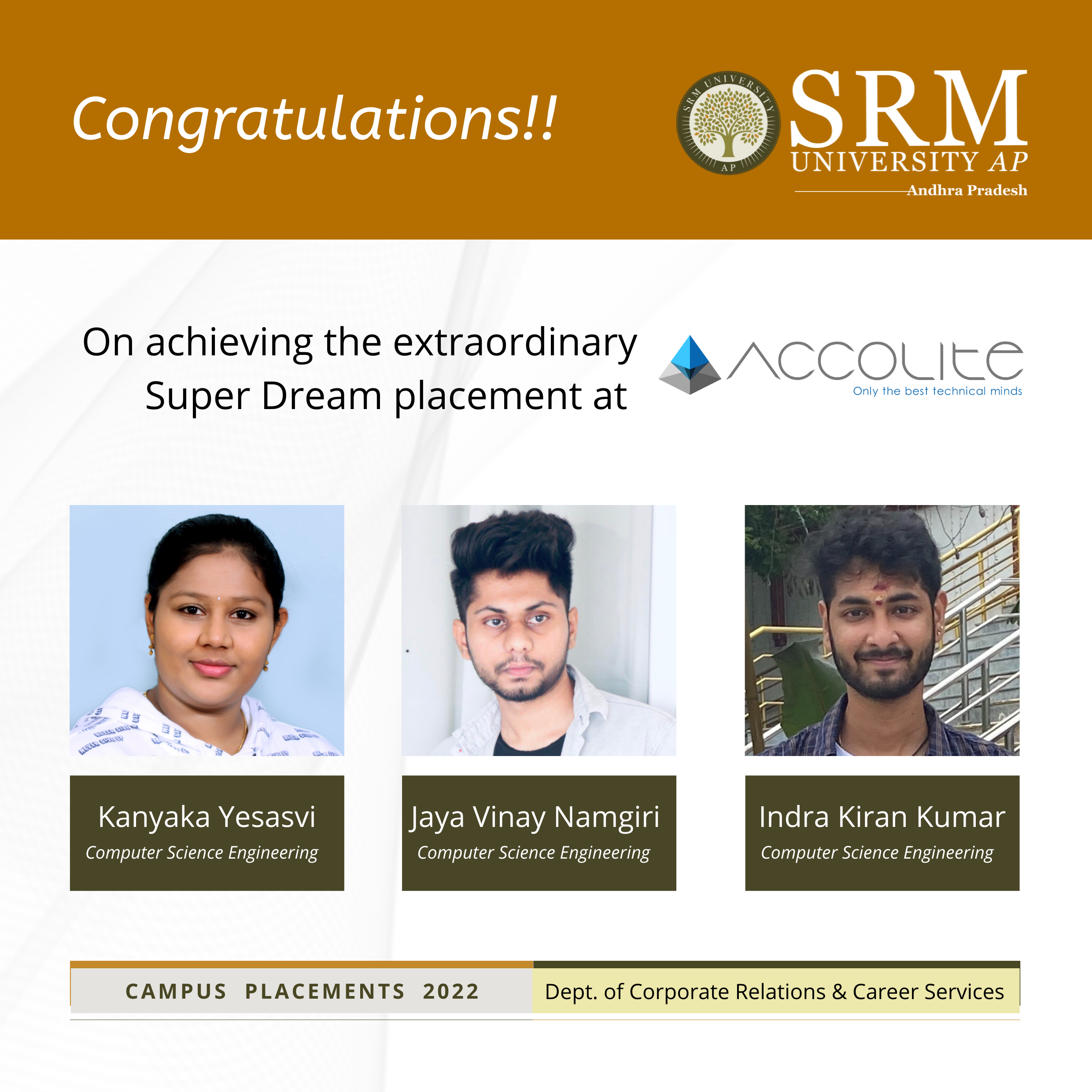 Kanyaka Yesasvi, Jaya Vinay Namgiri, Payeli Indra Kiran Kumar, three vibrant students from the Department of Computer Science Engineering get placed in the reputed digital and product engineering services and solutions company Accolite Digital with an exciting CTC of 11LPA.
Kanyaka Yesasvi, Jaya Vinay Namgiri, Payeli Indra Kiran Kumar, three vibrant students from the Department of Computer Science Engineering get placed in the reputed digital and product engineering services and solutions company Accolite Digital with an exciting CTC of 11LPA.
Accolite Digital, founded in 2007, is a cutting-edge, best-in-class digital transformation services company that has successfully delivered design-driven challenging digital transformation efforts to Fortune 500 companies. They accomplish so by using a network of talented and passionate technologists to simplify their clients’ digital journeys through human-centric design and product innovation Accolite Digital is able to generate compelling business outcomes and when applied to any organisation, this encourages cross-team collaboration to drive transformed digital experiences. Their agile product innovation strategy speeds up design and development while offering a high return on investment.
The curriculum of SRM university-AP consists of training for placements beginning from the second year of graduate studies. It helps students to plan for the recruitment drive beforehand. The curriculum of placement consists of CCC training where students are divided into batches given individual attention on respective domains.
Let’s look into what our students say:
Kanyaka Yesasvi:
When I got to know that I received an offer in Accolite Digital as a software engineer I was overwhelmed with happiness. From July till date more than 80 companies visited us. Every day we are applying to multiple organisations through our placement cell. I am grateful to SRM University for giving me extraordinary opportunities to launch my career.
Payeli Indra Kiran Kumar:
The CR&CS department gives training on all important aspects required for us to crack the placement, like coding classes, contests, mock interviews, mock GD etc. I started preparing for the interviews using the materials provided by CCC. The faculty in my CSE department helped in all possible ways that they can. I suggest to juniors to make use of all the opportunities provided by the university and learn core subjects like DSA, OS, DBMS and CN for cracking super dream placement offers.
Jaya Vinay Namgiri:
Acceleration bootcamp provided by CCC helped me brush up on my coding skills and made me ready to face the companies in the Placement drive 2022. I thank the placement team for providing a helpdesk virtually in spite of this covid situation. That cleared all my doubts and helped me to plan accordingly. I would like to suggest my juniors develop any one project of their interest every year so that at the end of the third year they will be ready to face the recruitment drive.
- Published in CSE NEWS, Departmental News, News, Students Achievements
Resource and network-aware data placement algorithm for periodic workloads in cloud
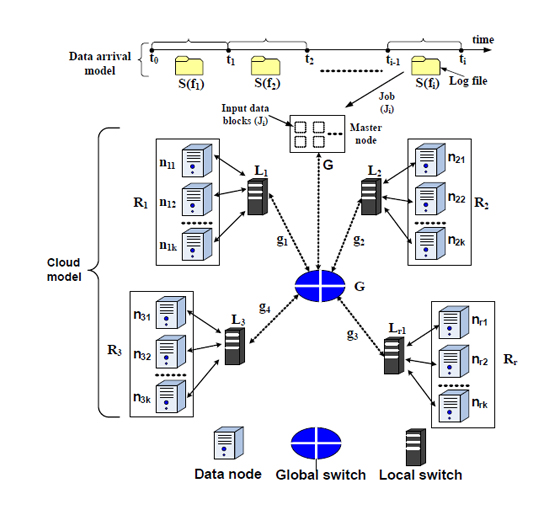 Dr Hirenkumar Thakkar from the Department of Computer Science and Engineering has published a research paper titled “RENDA: Resource and Network-aware Data Placement Algorithm for Periodic Workloads in Cloud” in the journal IEEE Transactions on Parallel and Distributed Systems Vol. 32, No. 12, pp. 2906-2920.
Dr Hirenkumar Thakkar from the Department of Computer Science and Engineering has published a research paper titled “RENDA: Resource and Network-aware Data Placement Algorithm for Periodic Workloads in Cloud” in the journal IEEE Transactions on Parallel and Distributed Systems Vol. 32, No. 12, pp. 2906-2920.
Each year, tech giants are spending millions of dollars to purchase the resources to store the data. However, efficient data placement is a critical issue for companies that experience several terabytes of data generation on daily basis. With such speed of data generation, it is the need of the hour to come up with a strategy for an efficient storage mechanism. This research investigates the data placement problems in cloud data centres and assists several tech giants such as Google, Facebook etc., to manage the cloud resource properly.
This research benefits society with a lower cost of cloud subscriptions, as tech giants are able to save several thousands of dollars by means of an efficient storage mechanism. This ultimately enables the tech giants to offer cloud service subscriptions at a reasonable cost.
The study was carried out in collaborations with Artificial Intelligence and Big Data Computing Lab (ABC Lab), Chang Gung University, Taiwan with Prof. Prasan Kumar Sahoo and in collaboration with Prof. Bharadwaj Veeravalli from the National University of Singapore. In addition to the current collaboration, there are several collaborations with the Indian Institute of Technology (IIT-BHU) as well as the University of Tartu, Estonia.
In future, Dr Thakkar is planning to come up with a book on cloud resource management using Nature-inspired learning. In addition to that, there are few projects such as filing two separate patents on Healthcare data analysis and opinion feature mining in collaboration with Chang Gung University, Taiwan, the National University of Singapore, and the University of Tartu, Estonia.
Read the full paper here: https://doi.org/10.1109/TPDS.2021.3080582
- Published in CSE NEWS, Departmental News, News, Research News
Dr Varaprasad Reddy joins orientation programme to motivate students
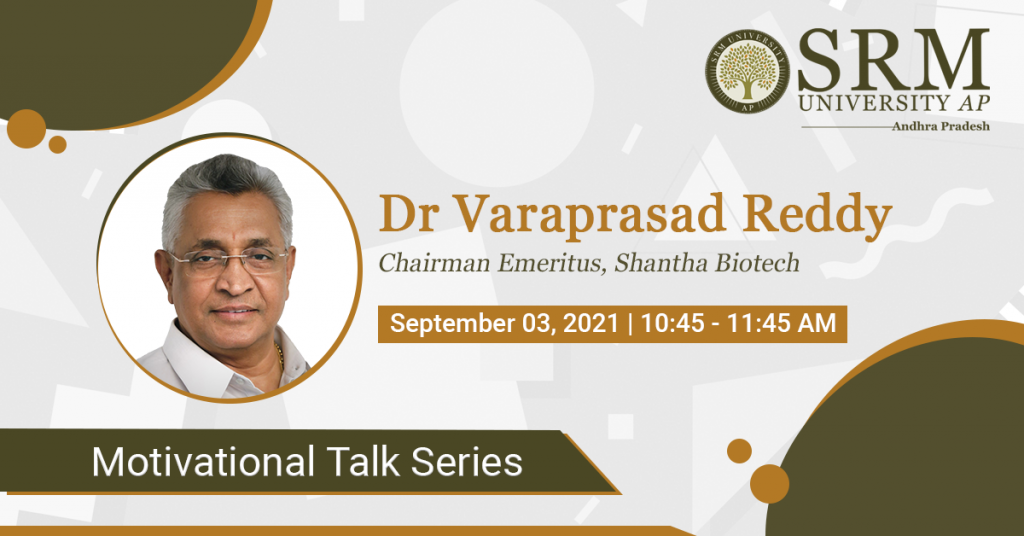 In the next chapter of the Freshmen Orientation Programme-2021, PADMA BHUSHAN Dr Varaprasad Reddy – Founder & Chairman of Shantha Biotechnics Ltd. will be joining us on September 03, 2021, at 10.45 am to meet and greet the new students.
In the next chapter of the Freshmen Orientation Programme-2021, PADMA BHUSHAN Dr Varaprasad Reddy – Founder & Chairman of Shantha Biotechnics Ltd. will be joining us on September 03, 2021, at 10.45 am to meet and greet the new students.
Dr Varaprasad Reddy is a versatile personality who has excelled in various domains of science and technology, entrepreneurship, and industrial development. He is the founder of Shantha Biotechnics, a company that purposes to produce cost-efficient vaccines for the dwellers of India. Shantha Biotechnics developed India’s first ‘indigenously developed’ vaccine against Hepatitis-B, which was made available in the market at a much-reduced cost compared to the imported alternatives.
The credit is due to Dr Varaprasad Reddy and his vision for enabling India to become the leading manufacturer of vaccines. His fervour to contribute to the country won him several accolades, such as the coveted PADMA BHUSHAN award from the government of India and honorary ‘doctorate’ from various universities of repute. The Freshmen 2021 are encouraged to avail the opportunity of attending the session with the illustrious Dr Varaprasad Reddy on September 03, 2021, at 10.45 am, who would propel you towards brilliance and compassion.
- Published in CSE NEWS, Events, Students Affairs Events

